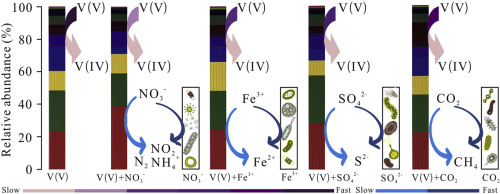Environmental Pollution ( IF 7.6 ) Pub Date : 2017-09-12 , DOI: 10.1016/j.envpol.2017.08.111 Hui Liu , Baogang Zhang , Heyang Yuan , Yutong Cheng , Song Wang , Zhen He

|
Vanadium (V) pollution in groundwater has posed serious risks to the environment and public health. Anaerobic microbial reduction can achieve efficient and cost-effective remediation of V(V) pollution, but its interactions with coexisting common electron acceptors such as NO3−, Fe3+, SO42− and CO2 in groundwater remain unknown. In this study, the interactions between V(V) reduction and reduction of common electron acceptors were examined with revealing relevant microbial community and identifying dominant species. The results showed that the presence of NO3− slowed down the removal of V(V) in the early stage of the reaction but eventually led to a similar reduction efficiency (90.0% ± 0.4% in 72-h operation) to that in the reactor without NO3−. The addition of Fe3+, SO42−, or CO2 decreased the efficiency of V(V) reduction. Furthermore, the microbial reduction of these coexisting electron acceptors was also adversely affected by the presence of V(V). The addition of V(V) as well as the extra dose of Fe3+, SO42− and CO2 decreased microbial diversity and evenness, whereas the reactor supplied with NO3− showed the increased diversity. High-throughput 16S rRNA gene pyrosequencing analysis indicated the accumulation of Geobacter, Longilinea, Syntrophobacter, Spirochaeta and Anaerolinea, which might be responsible for the reduction of multiple electron acceptors. The findings of this study have demonstrated the feasibility of anaerobic bioremediation of V(V) and the possible influence of coexisting electron acceptors commonly found in groundwater.
中文翻译:

地下水中钒的微生物还原:与共存电子受体的相互作用和微生物群落分析
地下水中的钒污染已严重危害环境和公众健康。厌氧微生物还原可以达到V(V)的污染高效和成本有效的补救,但它与共存的公共电子相互作用受体如NO 3 - ,铁3+,SO 4 2-和CO 2在地下水仍是未知的。在这项研究中,V(V)还原和普通电子受体的还原之间的相互作用进行了研究,揭示了相关的微生物群落并确定了优势种。结果表明,NO的存在3 -在反应的早期阶段减慢去除V(V),但最终导致了类似的还原效率(90.0%±72小时的操作0.4%),以在反应器而不NO 3 - 。Fe 3+,SO 4 2-或CO 2的添加降低了V(V)还原的效率。此外,这些共存电子受体的微生物还原也受到V(V)的不利影响。添加V(V),以及Fe组成的额外剂量的3+,SO 4 2-和CO 2减少微生物多样性和均匀度,而用NO供给反应器3 -显示出增加的多样性。高通量的16S rRNA基因焦磷酸测序分析表明的积累地杆菌,Longilinea,Syntrophobacter,螺旋体和Anaerolinea,这可能是负责多个电子受体的还原。这项研究的结果证明了V(V)进行厌氧生物修复的可行性以及地下水中常见的电子受体共存的可能影响。











































 京公网安备 11010802027423号
京公网安备 11010802027423号